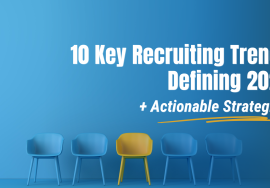
Employer Brand Self-Audit: A Step-by-Step Guide
Employer branding is the backbone of successful talent acquisition and employee retention. To understand where your company stands and to build a strategy that resonates with prospective and current employees, conducting an employer brand self-audit is an essential step. This process allows organizations to reflect on their employer brand, identify gaps, and create an action plan to attract and retain the best talent.
Below, we present a thorough guide to help you carry out a meaningful employer brand audit that yields actionable insights.
Step 1: Define the Objectives
The first step in any effective employer brand audit is to clearly define your objectives. What are you trying to achieve? Are you seeking to understand your company’s current reputation, identify weaknesses, evaluate cultural alignment, or measure how well your employer value proposition (EVP) resonates with employees and candidates? Be as specific as possible. Defining clear objectives will guide the entire process and ensure that your findings are actionable.
Example Objectives:
- Assess alignment between the company’s values and employee perceptions.
- Evaluate strengths and weaknesses of the current employer brand.
- Identify opportunities to improve employee experience.
Step 2: Identify Key Stakeholders
Identify internal and external stakeholders who have a vested interest in the employer brand. Stakeholders might include current employees, prospective candidates, alumni, industry partners, and even customers. Understanding their perspectives will help you paint a comprehensive picture of your employer brand.
Examples of Key Stakeholders:
- Current employees: Gather insights into their day-to-day experiences.
- Prospective candidates: Understand perceptions formed from the application and recruitment process.
- Alumni: Gain perspective on why people leave and what they think of the company post-employment.
Step 3: Assemble a Cross-Functional Team
Employer branding impacts and is influenced by many departments. Assemble a cross-functional team that includes representatives from HR, marketing, communications, and other key departments. Each function will provide unique insights into how the employer brand is perceived and executed, both internally and externally.
Key Team Members Could Include:
- HR leaders who understand employee sentiment.
- Marketing specialists who can provide insight into brand positioning.
- Communication experts who shape internal and external messaging.
Step 4: Develop an Audit Framework
An audit framework will help structure your efforts and ensure that you’re examining all relevant areas. Consider developing a set of questions that assess various dimensions of your employer brand, such as perception, culture, values, employee experience, and communications.
Audit Framework Dimensions:
- Perception: How do employees and candidates perceive your brand?
- Culture and Values: Are these elements consistently communicated and lived within the organization?
- Employee Experience: Is the experience from recruitment to onboarding aligned with expectations?
- Communications: Are your brand messages consistent across channels?
Step 5: Review Internal Documents and Policies
Evaluate internal documents like employee handbooks, policies, onboarding materials, and training resources. Do these materials reflect the employer brand you want to project? Are there any inconsistencies between the brand values you promote and what’s in your internal documents?
Documents to Review:
- Employee handbook.
- Onboarding materials.
- Internal newsletters and policy documents.
Step 6: Conduct Internal Interviews and Surveys
Employee feedback is invaluable. Conduct interviews and surveys with employees across all levels and departments to gauge their perceptions of the employer brand. Be sure to ask open-ended questions to get a deeper understanding of their views on leadership, career development, work-life balance, and more.
Suggested Tools:
- Employee Surveys: Use platforms like SurveyMonkey or Culture Amp.
- Focus Groups: Gather qualitative insights through small group discussions.
Step 7: Analyze Your Online Presence
A significant part of your employer brand audit will be to evaluate your online presence. Review your company’s career page, social media profiles, and profiles on review sites. Consistency is key—your messaging should be uniform and reflect your desired employer brand across all platforms.
Key Areas to Evaluate:
- Career page content.
- Employer profiles on LinkedIn, Glassdoor, and Indeed.
- Social media messaging consistency and engagement levels.
Step 8: Gather External Feedback
Your external reputation is just as important as internal perception. Collect feedback from past job applicants, industry partners, alumni, and even customers if they’ve interacted with your employer brand in some way. Use surveys, focus groups, and online reviews to understand the external narrative.
External Channels to Tap Into:
- Glassdoor and Indeed reviews.
- Candidate feedback from interview processes.
- Social media comments and engagement metrics.
Step 9: Review Recruitment and Onboarding Processes
Your recruitment and onboarding processes are critical elements of your employer brand. Audit the entire candidate experience—from job posting to the final onboarding—to ensure every step reflects your company’s culture and values. The goal is to ensure that prospective employees are given an authentic and consistent impression of your organization.
Aspects to Consider:
- Application process: Is it easy, user-friendly, and mobile-compatible?
- Job postings: Are they appealing and accurately reflecting your EVP?
- Onboarding experience: Does it make new hires feel welcomed and valued?
Step 10: Assess Employee Benefits and Wellness Programs
Employee benefits are a significant part of what attracts talent. Assess the comprehensiveness and competitiveness of your benefits package and wellness programs. Are they meeting the needs of your current workforce, and are they attractive to potential candidates?
Areas to Assess:
- Health and wellness programs.
- Work-life balance initiatives.
- Professional development opportunities.
Step 11: Analyze the Gathered Data
Once you’ve gathered all the necessary data, take the time to conduct a comprehensive analysis. Look for trends, themes, and insights that emerge from employee feedback, external reviews, and online audits. Use these insights to draw conclusions about your employer brand’s strengths and areas for improvement.
Analysis Tips:
- Identify themes and categorize them into strengths and weaknesses.
- Use data visualization tools to present findings in an easy-to-digest manner.
Step 12: Identify Areas for Improvement
Based on the analysis, pinpoint specific areas that need improvement. It could be related to improving communication channels, enhancing employee benefits, or tweaking your recruitment approach.
Common Improvement Areas:
- Lack of transparency in career progression opportunities.
- Misalignment between stated company values and employee experiences.
- Limited external visibility on social media.
Step 13: Develop an Action Plan
Create a comprehensive action plan that lays out specific steps, initiatives, and strategies to address the identified gaps. Assign responsibilities, set timelines, and establish measurable KPIs to track progress over time.
Key Elements of Your Action Plan:
- Actionable initiatives (e.g., improve onboarding experience).
- Assigned team members to each initiative.
- Key Performance Indicators (KPIs) to track improvements.
Step 14: Implement and Monitor Progress
Implement the action plan and track progress regularly. Monitoring helps ensure that the intended changes are producing the desired outcomes. It’s also important to stay flexible—adjust strategies as necessary to maximize impact.
Monitoring Tools:
- Employee surveys to gather ongoing feedback.
- Regular check-ins with the cross-functional team to assess progress.
Step 15: Communicate the Findings
Transparency is key. Communicate the results of the audit to key stakeholders, including employees, leadership, and external partners. Share what actions are being taken and how these changes will benefit everyone involved.
Communication Channels:
- Company-wide meetings.
- Internal newsletters.
- External updates on your career pages and social media platforms.
Step 16: Continuously Evaluate and Improve
Employer branding is not a one-time project—it’s an ongoing journey. Regularly revisit the audit process to ensure your brand remains strong and aligned with your company values. Seek feedback from both employees and external stakeholders to stay in tune with their experiences.
Tips for Ongoing Improvement:
- Schedule bi-annual brand audits.
- Keep track of employer brand metrics like employee engagement, retention rates, and quality of hire.
- Stay updated with industry trends to ensure your employer brand remains competitive.
Conclusion: Laying the Foundation for a Stronger Employer Brand
Conducting an employer brand self-audit is an intentional and thorough process that provides the foundation for building a strong and authentic employer brand. It involves a deep dive into internal and external perspectives, a structured framework for evaluation, and a commitment to ongoing improvement. Companies that prioritize employer branding benefit from increased talent attraction, higher retention rates, and a more engaged workforce.
Ready to take your employer brand to the next level? Armada Workforce, a recruiting and employer branding agency, has the expertise and tools to support your audit journey and provide valuable insights into your company’s brand perception. Our Employer Branding Audit Questionnaire is an excellent starting point for identifying gaps and opportunities within your organization. Get in touch today to see how we can help.









